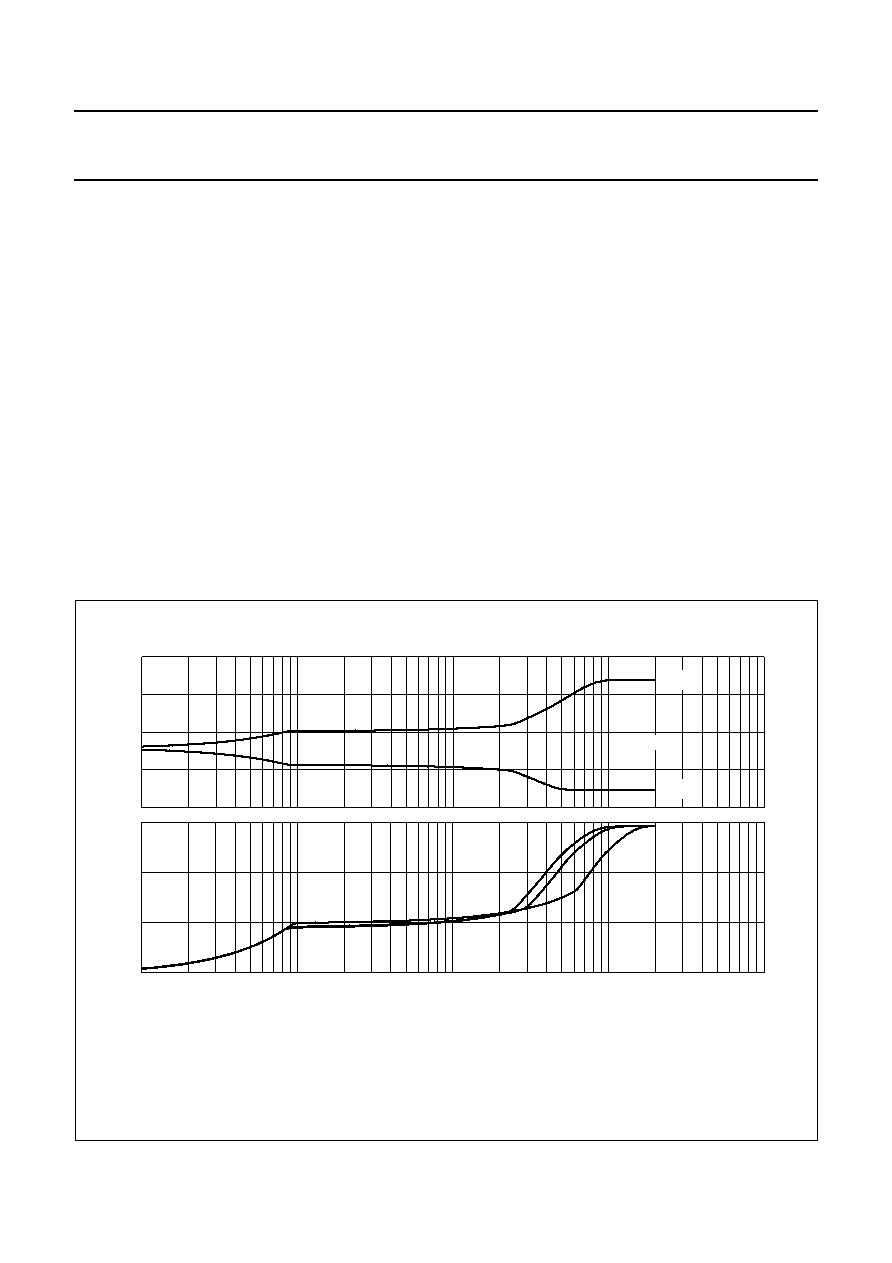- 您現(xiàn)在的位置:買賣IC網(wǎng) > PDF目錄24810 > 935262598026 (NXP SEMICONDUCTORS) SPECIALTY TELECOM CIRCUIT, UUC13 PDF資料下載
參數(shù)資料
| 型號(hào): | 935262598026 |
| 廠商: | NXP SEMICONDUCTORS |
| 元件分類: | 通信及網(wǎng)絡(luò) |
| 英文描述: | SPECIALTY TELECOM CIRCUIT, UUC13 |
| 封裝: | DIE-13 |
| 文件頁(yè)數(shù): | 23/26頁(yè) |
| 文件大小: | 258K |
| 代理商: | 935262598026 |
第1頁(yè)第2頁(yè)第3頁(yè)第4頁(yè)第5頁(yè)第6頁(yè)第7頁(yè)第8頁(yè)第9頁(yè)第10頁(yè)第11頁(yè)第12頁(yè)第13頁(yè)第14頁(yè)第15頁(yè)第16頁(yè)第17頁(yè)第18頁(yè)第19頁(yè)第20頁(yè)第21頁(yè)第22頁(yè)當(dāng)前第23頁(yè)第24頁(yè)第25頁(yè)第26頁(yè)

2000 Mar 29
6
Philips Semiconductors
Product specication
SDH/SONET STM4/OC12
transimpedance amplier
TZA3023
AGC
TZA3023 transimpedance amplifier can handle input
currents from 0.5
A to 1.5 mA. This means a dynamic
range of 72 dB. At low input currents, the transimpedance
must be high to get enough output voltage, and the noise
should be low enough to guaranty minimum bit error rate.
At high input currents however, the transimpedance
should be low to avoid pulse width distortion. This means
that the gain of the amplifier has to vary depending on the
input signal level to handle such a wide dynamic range.
This is achieved in the TZA3023 by implementing an
Automatic Gain Control (AGC) loop.
The AGC loop consists of a peak detector, a hold capacitor
and a gain control circuit. The peak amplitude of the signal
is detected by the peak detector and it is stored on the hold
capacitor. The voltage over the hold capacitor is compared
to a threshold level. The threshold level is set to
10
A (p-p) input current. AGC becomes active only for
input signals larger than the threshold level.
It is disabled for smaller signals. The transimpedance is
then at its maximum value (21 k
differential).
When the AGC is active, the feedback resistor of the
transimpedance amplifier is reduced to keep the output
voltage constant. The transimpedance is regulated from
21 k
at low currents (I < 10 A) to 800 at high currents
(I < 500
A). Above 500 A the transimpedance is at its
minimum and can not be reduced further but the front-end
remains linear until input currents of 1.5 mA.
The upper part of Fig.7 shows the output voltages of the
TZA3023 (OUT and OUTQ) as a function of the DC input
current. In the lower part, the difference of both voltages is
shown. It can be seen from the figure that the output
changes linearly up to 10
A input current where AGC
becomes active. From this point on, AGC tries to keep the
differential output voltage constant around 200 mV for
medium range input currents (input currents <200
A).
The AGC can not regulate any more above 600
A input
current, and the output voltage rises again with the input
current.
handbook, full pagewidth
0
600
400
200
MCD914
1102
10
(1)
(2)
(3)
Ii (A)
Vo
(V)
Vo(dif)
(mV)
103
104
1
1.2
1.6
1.4
1.8
VCC = 3 V
VOUT
VOUTQ
Fig.7 AGC characteristics.
Vo(dif) =VOUT VOUTQ.
(1) VCC =3V.
(2) VCC = 3.3 V.
(3) VCC =5V.
相關(guān)PDF資料 |
PDF描述 |
|---|---|
| 935262597112 | SPECIALTY TELECOM CIRCUIT, PDSO8 |
| 07SR-3S | Photovoltaic MOSFET Driver (4-pin SOP) |
| 935263380518 | TELEPHONE SPEECH CKT, PDSO16 |
| 935263380512 | TELEPHONE SPEECH CKT, PDSO16 |
| 935263379112 | TELEPHONE SPEECH CKT, PDIP16 |
相關(guān)代理商/技術(shù)參數(shù) |
參數(shù)描述 |
|---|---|
| 935264217557 | 制造商:NXP Semiconductors 功能描述:SUB ONLY IC |
| 935267356112 | 制造商:NXP Semiconductors 功能描述:IC TEA1507PN |
| 935268081112 | 制造商:NXP Semiconductors 功能描述:SUB ONLY IC |
| 935268721125 | 制造商:NXP Semiconductors 功能描述:Buffer/Line Driver 1-CH Non-Inverting 3-ST CMOS 5-Pin TSSOP T/R |
| 935269304128 | 制造商:ST-Ericsson 功能描述:IC AUDIO CODEC W/TCH SCRN 48LQFP |
發(fā)布緊急采購(gòu),3分鐘左右您將得到回復(fù)。